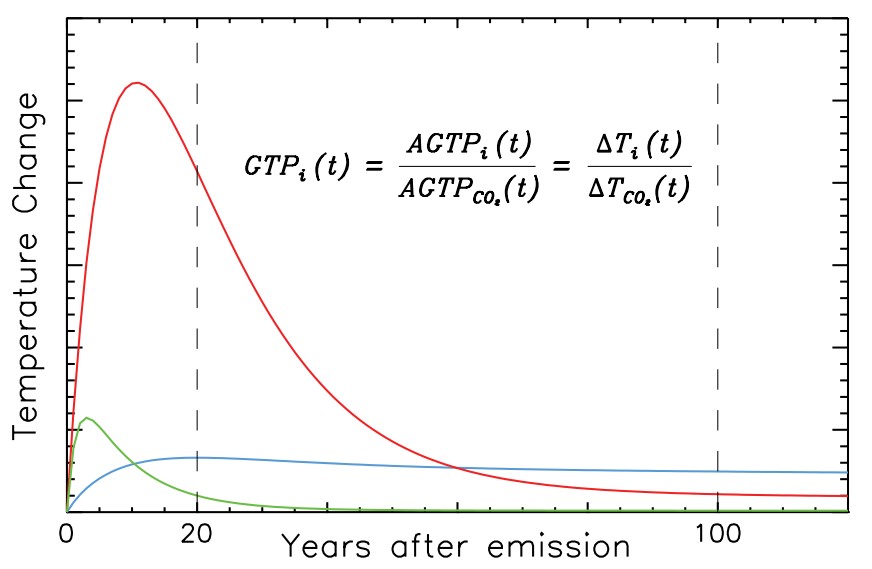Can global temperature change potential replace GWP in upcoming regulations?
written by Pavel Makhnatch (under supervision of Rahmatollah Khodabandeh and Björn Palm)
The Global Warming Potential (GWP) is widely used, but also widely criticized environmental metric. It is criticized for not being able to address the needs of current and future environmental policies that are designed to ensure global benefits at the lowest possible cost. Therefore, a number of metrics, alternative to GWP, have been introduces over the years. We discuss few of them in this article.
GWP metric was a topic of our discussion in previous issue of KYLA+. On one hand, the use of GWP helps to quantify and communicate the relative and absolute contributions to climate change of emissions of different substances. On the other hand, low GWP value does not guarantee similarly low environmental impact of the substance. Hence, there is an interest for the alternative metrics, which can address the drawbacks of GWP.
What is wrong with GWP?
GWP was suggested as a metric to evaluate possible policy options. GWP with time horizon of 100 years has been a metric of a choice in the Kyoto Protocol. Although a choice of a time horizon has significant effect on the GWP value, the selection of 100 year time horizon is arbitrary and not scientifically justified.
Despite its name, the global warming potential does not actually represent the impact of gas emissions on global warming (global mean temperature increase). Although a strong greenhouse gas with a short lifetime could have the same GWP as a weaker greenhouse gas with a longer lifetime, identical (in mass terms) pulse emissions of the two gases could cause quite different temporal behavior of temperature change [1].
The comparison, presented in Table 1, compares methane with two fictitious gases “NN-short” and “NN-long”. It can be seen, that the temperature response to a pulse emissions of these gases (indicated in GTP100 values) differs significantly, in spite of the equal GWP100 values of all the three gases. Here GTP100 represents new environmental metric that we would like to discuss further.
Table 1 - Comparison of GTP100 of methane and two hypothetical methane-like gases with an identical 100-year GWP but different radiative forcings and lifetimes [1].
| Lifetime |
GWP100 |
GTP100 |
|
| “NN short” |
4 |
22 |
0.01 |
| CH4 |
12 |
22 |
0.35 |
| “NN long” |
20 |
22 |
2.2 |
IS GTP a better global warming potential indicator?
GTP is one of the other alternative metrics created to facilitate policymakers. GTP stands for Global Temperature change Potential and represents the ratio of the absolute change in global mean surface temperature at a chosen point in time in response to an emission pulse, relative to the temperature change due to the emission of equal amount of CO2 (Figure 2).
Unlike the time integrated GWP metric, GTP is an end-point metric that is based on temperature change for a selected year. It can be suitable for a target based climate policies, where the target is set, for instance, to keep the surface temperature change below some value (e.g. below 2 °C)

Like GWP, the GTP values can be used for weighting the emissions to obtain ‘CO2 equivalents’. This gives the temperature effects of emissions relative to that of CO2 for the chosen time horizon. As for GWP, the choice of time horizon has a strong effect on the metric values and the calculated contributions to warming.
The GWP and GTP are fundamentally different by construction and different numerical values can be expected. In particular, GWP100 of R32 is 4.9 times higher than the GWP100 of R152a, whereas the GTP100 of R32 (94) is 47 times higher than GTP100 of R152a (2). In fact, the contrast between the GWP and GTP values is particularly noticeable for gases with short and medium lifetimes and reflects the integral nature of the GWP which retains memory of the strong shortlived forcing, while the GTP, being an end-point metric, has less of a “memory”.
The monetary value of global warming
GTP and GWP - purely physically based metrics - has been criticized by economists since they do not reflect the cost required to remove particular greenhouse gas emission. Meanwhile, United Nations estimate that the cost of holding rising temperatures to safe levels may reach 4 percent of economic output by 2030 [3]. Hence, a number of new metrics have been developed to add economic dimensions as well.
Global Cost Potential (GCP) and Global Damage Potential (GDP) are the metrics that account for economic factors such as mitigation costs, damage costs and discount rates. Both metrics are determined within an integrated climate–economy model, since they are affected both by the response of the climate system as well as by economic factors.
Despite all criticisms and the suggestion of many alternatives, the GWP seems to have retained its widespread use, mainly because of the simplicity of its definition and relative ease of calculation, compared to some of the alternatives.
GTP, in turn, retain some of the attractions of the GWP, such as a transparent formulation and reliance on relatively few parameters. Hence, it is likely that we will see increased use of GTP in the coming future. It can be possible that in the future we can discuss “low GTP refrigerants” similarly to the way we are discussing low GWP refrigerants today.
Follow our publications and sign up for our newsletter to get more new: .
Referenser:
| [1] |
K. P. Shine, J. S. Fuglestvedt and N. Stuber, "An alternative to the Global Warming Potential for comparing climate impacts of emissions of greenhouse gases," 2003. |
| [2] |
IPCC, "Fifth Assessment Report," Cambridge University Press, Cambridge, Great Britain, New York, NY, USA and Melbourne, Australia, 2013. |
| [3] |
A. Morales, "Climate Protection May Cut World GDP 4% by 2030, UN Says," Bloomberg, 17 Jan 2014. [Online]. Available: bloom.bg/PoN6Kw. |
